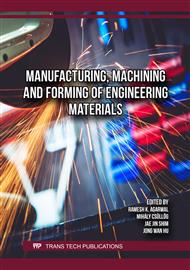[1]
Petrina, Yvonne. "Jewellery from Late Antique Egypt." British Museum Studies in Ancient Egypt and Sudan, vol. 21, 2014, p.31–43. ISSN 2049-5021.
Google Scholar
[2]
J2X Systems. "A Brief History of Wire Straightening." [https://j2xsystems.com/blogs/blog/a-brief-history-of-wire-straightening]. Retrieved October 11, 2024, from https://j2xsystems.com/bl-ogs/blog/a-brief-history-of-wire-straightening).
Google Scholar
[3]
English Standard Version Bible. 2001, Exod. 39:3. Retrieved October 11, 2024, from https://esv.literalword.com/
Google Scholar
[4]
Patel, Paresh, Digesh Joshi, and Rinkesh Makawana. "Experimental Studies to Evaluate Tensile and Bond Strength of Stainless-Steel Wire Mesh (SSWM)." Frattura ed Integrità Strutturale, vol. 17, no. 65, 2023, pp.257-269.
DOI: 10.3221/igf-esis.65.17
Google Scholar
[5]
Study Smarter. "Springs Physics." [https://www.studysmarter.co.uk/explanations/physics/dy-namics/springs physics/] (Retrieved October 12, 2024, from https://www.studysmarter.co.uk/explanations/physics/dynamics-/springs-physics/).
Google Scholar
[6]
Nevárez-Rascón, Alfredo, et al. "Nanomechanical and Bending Properties of Nickel-Titanium Orthodontics Archwires by Depth-Sensing Indentation."
DOI: 10.1016/j.ajodo.2024.08.009
Google Scholar
[7]
Haleem, Abid, et al. "Exploring the Potential of 3D Scanning in Industry 4.0: An Overview." International Journal of Cognitive Computing in Engineering, vol. 3, 2022, pp.161-171. ISSN 2666-3074.
DOI: 10.1016/j.ijcce.2022.08.003
Google Scholar
[8]
Mostafa, Abdel-Bary, and Mostafa Ebrahim. "3D Laser Scanners' Techniques Overview." International Journal of Science and Research (IJSR), vol. 4, 2015, pp.5-611.14.
Google Scholar
[9]
Wang, Rongxuan, et al. "Development of Structured Light 3D-Scanner with High Spatial Resolution and Its Applications for Additive Manufacturing Quality Assurance." The International Journal of Advanced Manufacturing Technology, vol. 84, 2021.
DOI: 10.21203/rs.3.rs-409368/v1
Google Scholar
[10]
Javaid, Mohd, et al. "Industrial Perspectives of 3D Scanning: Features, Roles and Its Analytical Applications." Sensors International, vol. 2, 2021, article no. 100114. ISSN 2666-3511.
DOI: 10.1016/j.sintl.2021.100114
Google Scholar
[11]
Wi, Kwangwoo, et al. "Quantifying Quality of 3D Printed Clay Objects Using a 3D Structured Light Scanning System." Additive Manufacturing, vol. 32, 2020, article no. 100987.
DOI: 10.1016/j.addma.2019.100987
Google Scholar
[12]
Martins, Fernando António Rodrigues, et al. "Automated 3D Surface Scanning Based on CAD Model." Mechatronics, vol. 15, no. 7, 2005, pp.837-857. ISSN 0957-4158.
DOI: 10.1016/j.mechatronics.2005.01.004
Google Scholar
[13]
Aslan, Gökhan, E. İlhan Konukseven, and A. Buğra Koku. "Design and Implementation of a 3D Scanning Platform for Mobile Robotic Applications." International Journal of Design Engineering, vol. 5, no. 4, 2014, pp.358-373.
DOI: 10.1504/ijde.2014.067078
Google Scholar
[14]
Noel, Julien. "Uses and Advances of Computed Tomography for 3D Scanning of Industrial Parts." Materials Evaluation, vol. 68, no. 5, 2010, pp.26-31.
Google Scholar
[15]
Alarcón, Daniel J., et al. "Modal model validation using 3D SLDV, geometry scanning and fem of a multi-purpose drone propeller blade." Rotating Machinery, Hybrid Test Methods, Vibro-Acoustics & Laser Vibrometry, Volume 8: Proceedings of the 35th IMAC, A Conference and Exposition on Structural Dynamics 2017. Springer International Publishing, 2017.
DOI: 10.1007/978-3-319-54648-3_2
Google Scholar
[16]
IDCSpring. https://idcspring.com/resources/articles/spring-manufacturing-process/ Retrie-ved March 7 2025 from https://idcspring.com/resources/articles/spring-manufacturing-process/
Google Scholar



